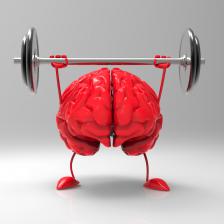How to Live Longer by Gaining Muscle
Get-Fit Guy has the surprising truth about the connection between your muscles and your lifespan. Learn how muscle makes you live longer, why you may not need to do cardio, and how to maximize your muscle gain!
Ben Greenfield
Listen
How to Live Longer by Gaining Muscle
The older I get, the more I think about benefits of fitness that go above and beyond just looking good. Rather than just being worried about the effect of exercise on swimsuit season, I’m getting more appreciative of benefits like the brain boost you get from physical activity, the increased mobility and balance, and of course, the improvement in longevity..
But when it comes to longevity, what part of fitness gives you the most benefit? It turns out that the answer is not necessarily lung size, or flexibility, or speed. Instead, a new study shows that the more muscle you have, the lower your risk of death.
In the study, participants underwent tests to determine their muscle mass index, which is the amount of muscle relative to height. The investigators then used a follow-up survey to determine how many of the participants had died of natural causes and how muscle mass was related to death risk. People with the highest levels of muscle mass were significantly less likely to have died than those with the lowest levels of muscle mass.
So in today’s episode, you’re going to learn how muscle makes you live longer, whether you even need to do cardio, and how to maximize your muscle gain!
How Muscle Makes You Live Longer
According to a study performed at McMaster University in Hamilton, Ontario, resistance training activates a muscle stem cell called a satellite cell. Then, in a process called “gene shifting,” these new cells cause the energy-generating components of the cell called mitochondria, to rejuvenate. The study author says that via this process, after 6 months of twice weekly strength exercise training, the biochemical, physiological and genetic signature of older muscles are “turned back” by a factor of 15 to 20 years.
Other studies indicate that they type of high intensity exercise experienced during strength training protects your chromosomes too. Chromosomes are a threadlike structure of nucleic acids and protein found in the nucleus of most living cells, and carry genetic information in the form of genes. It appears that stimulating muscle increases the production of telomerase, what allows for the ongoing maintenance of genetic information and cellular integrity in the chromosomes. In addition, exercise triggers the production of antioxidants, which boosts the ability of the body to withstand environmental stressors such as pollutants and toxins.

Amazingly, studies show that elderly people can still experience the benefits of gene shifting even if they’ve never lifted weights before, as well as increased production of growth hormone and testosterone that comes from building muscle.
So are you ready to increase your lifespan through muscle gain?
Here’s the good news: I have plenty of episodes that tell you exactly how. I’d recommend you start with How to Build Muscle, then move on to 10 Tips To Build Muscle Fast.
But Don’t I Need Cardio?
But wait…with all this talk about strength training, aren’t you putting yourself at a cardiovascular deficit by not including cardio in your workouts?

In addition, in the Get-Fit Guy episode Weight Training Is Just as Good as Cardio, I introduce a study entitled “Resistance Training to Momentary Muscular Failure Improves Cardiovascular Fitness in Humans: A Review of Acute Physiological Responses and Chronic Physiological Adaptations”opens PDF file (yes, that’s a mouthful!). In the study resistance training to muscular failure resulted in the same type of cardiovascular adaptations you’d get if you were to go out for a long run. This included a better ability to buffer lactic acid and increased density of the mitochondria.
I also discuss many of the cardio benefits of weight training in the episode Is Weight Lifting Bad For Your Heart?
Now that’s not to say that you shouldn’t add any cardio into a strength training program. Here’s why: Adding high-intensity interval training may actually increase your rate of muscle gain!
So even though many exercise enthusiasts believe that adding cardio to a weight training session may actually decrease rate of muscle gain or ability to gain muscle at all, it’s simply not true! The new study “Maximal strength, power, and aerobic endurance adaptations to concurrent strength and sprint interval training” shows that doing sprinting or high-intensity interval training at the same time as you’re doing your weight training session actually increases strength and increases muscle synthesis!
A Tip for Adding Muscle Quickly
So, rather than just going to the gym and lifting weights, you could instead combine intense cardio with your weight training. For example, the following circuit would work quite nicely for the ultimate combination of muscle, cardio, and longevity:
-
Overhead dumbbell press – 8 reps, slow and controlled
-
Barbell squat – 8 reps, slow and controlled
-
Pull-up or pull-down, 8 reps, slow and controlled
-
Dumbbell walking lunge, 8 reps per leg
-
60 second all-out sprint on a bike, treadmill, or elliptical trainer
-
1 minute rest, then repeat the circuit 3-5 times.
Of course, you’d get pretty bored if you lived to 100 years old doing the same exercise routine over and over again, so it’s just fine to mix things up. And to make sure you do that, I promise to continue to give you new exercises and workouts to keep things fresh – just keep on listening to the Get-Fit Guy podcast for the latest in cutting edge exercise research and innovation.
If you have questions about how to live longer by gaining muscle, then post them in Comments below or join the discussion over at Facebook.com/GetFitGuy.
Strong brain, muscular back, arm muscle images courtesy of Shutterstock.

 Overhead
Overhead 